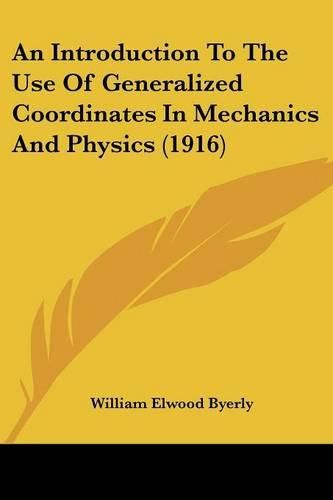An Introduction to the Use of Generalized Coordinates in Mechanics and Physics (1916)
William Elwood Byerly

An Introduction to the Use of Generalized Coordinates in Mechanics and Physics (1916)
William Elwood Byerly
AN INTRODUCTION TO THE USE OF GENERALIZED COORDINATES IN MECHANICS AND PHYSICS BY WILLIAM ELWOOD BYERLY PERKINS PROFESSOR OF MATHEMATICS EMERITUS IK HARVARD UNIVERSITY GINN AND COMPANY BOSTON - NEW TORK - CHICAGO ATLANTA - DALLAS COLUMBUS SAN FRANCISCO PREFACE This book was undertaken at the suggestion of my lamented colleague Professor Benjamin Osgood Peirce, and with the promise of his collaboration. His untimely death deprived me of his invalu able assistance while the second chapter of the work was still unfinished, and I have been obliged to complete my task without the aid of his remarkably wide and accurate knowledge of Mathe matical Physics. The books to which I am most indebted in preparing this treatise are Thomson and Taits u Treatise on Natural Philosophy Watson and Burburys Generalized Coordinates, Clerk Maxwells Elec tricity and Magnetism, E. J. Rouths Dynamics of a Rigid Body, 7 A. Gr. Websters Dynamics, andE. B. Wilsons Advanced Calculus. For their kindness in reading and criticizing my manuscript I am indebted to my friends Professor Arthur G-ordon Webster, Professor Percy Bridgman, and Professor Harvey Newton Davis. W. E. BYERLY iii CONTENTS CHAPTER I INTRODUCTION 1-37 ART. 1. Coordinates of a Point. Number of degrees of freedom. ART. 2. Dynamics of a Particle. Free Motion. Differential equa tions of motion in rectangular coordinates. Definition of effective forces on a particle. Differential equations of motion in any sys tem of coordinates obtained from the fact that in any assumed infinitesimal displacement of the particle the work done by the effective forces is equal to the work done by the impressed forces. ART. 3, Illustrative examples. ART. 4. Dynamics of aParticle. Constrained Motion. ART. 5. Illustrative example in constrained motion. Examples. ART. 6 a. The tractrix problem, b. Par ticle in a rotating horizontal tube. The relation between the rec tangular coordinates and the generalized coordinates may contain the time explicitly. Examples. ART. 7. A System of Particles. Effective forces on the system. Kinetic energy of the system. Coordinates of the system. Number of degrees of freedom. The geometrical equations. Equations of motion. ART. 8. A Sys tem of Particles. Illustrative Examples. Examples. ART. 9. Rigid Bodies. Two-dimensional Motion. Formulas of Art. 7 hold good. Illustrative Examples. Example. ART. 10. Rigid Bodies. Three dimensional Motion, a . Sphere rolling on a rough horizontal plane. 6. The billiard ball. Example, c. The gyroscope, d. Eulers equations. ART. 11. Discussion of the importance of skillful choice of coordinates. Illustrative examples. ART. 12. Nomen clature. Generalized coordinates. Generalized velocities. Gen eralized momenta. Lagrangian expression for the kinetic energy. Lagrangian equations of motion. Generalized force. ART. 13. Summary of Chapter I. CHAPTER II THE HAMILTONIAN EQUATIONS. BOTJTHS MODIFIED LA GRANGIAN EXPRESSION. IGNOKATION OF COORDINATES . 38-61 ART. 14. Hamiltonian Expression for the Kinetic Energy defined. Hamiltonian equations of motion deduced from the Lagrangian Equations. ART. 15. Illustrative examples of the employment of Hamiltonian equations. ART. 16. Discussion of problems solved in Article 15. Ignoring coordinates. Cyclic coordinates. Ignorable problem in hydromechani Tl CONTENTS vii function in the two configurations and is independent of the paths by which the particles havemoved from the first configura tion to the second. Definition of potential energy. ART. 39. The Lagrangian and the Hamiltonian Functions. Canonical forms of the L. agrangian and of the Hamiltonian equations of motion. The modified Lagrangian function 3. ART. 40. Porms of i, . H, and 3 compared. Total energy E of a system moving under conservative forces. ART. 41. When i, JET, or 4 is given, the equations of motion follow at once. When X is given, the kinetic energy and the potential energy can be dis tinguished by inspection…
This item is not currently in-stock. It can be ordered online and is expected to ship in approx 2 weeks
Our stock data is updated periodically, and availability may change throughout the day for in-demand items. Please call the relevant shop for the most current stock information. Prices are subject to change without notice.
Sign in or become a Readings Member to add this title to a wishlist.


